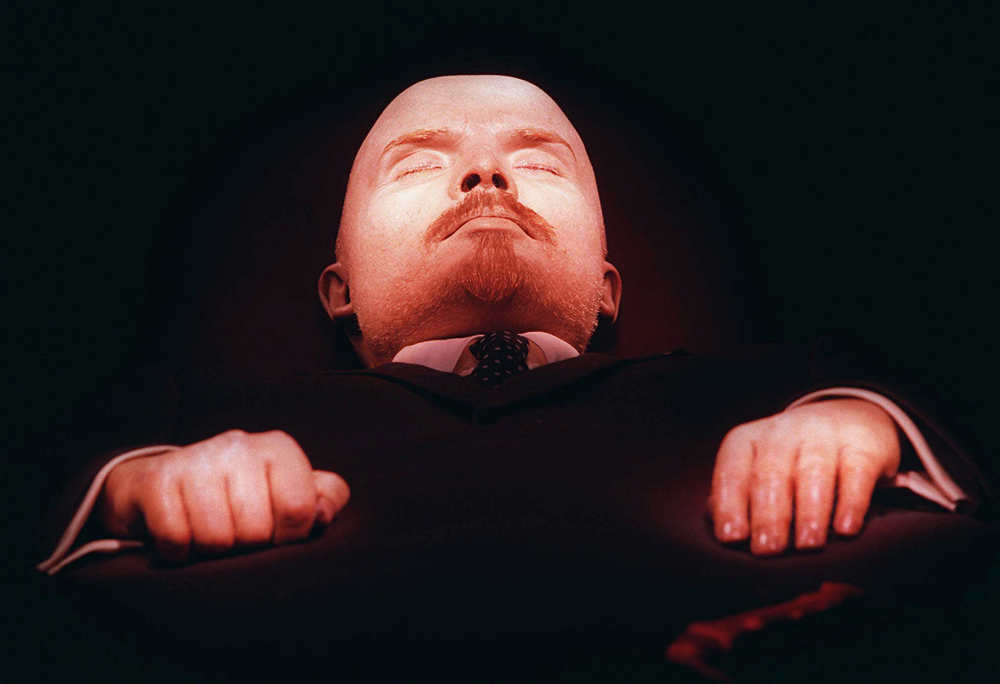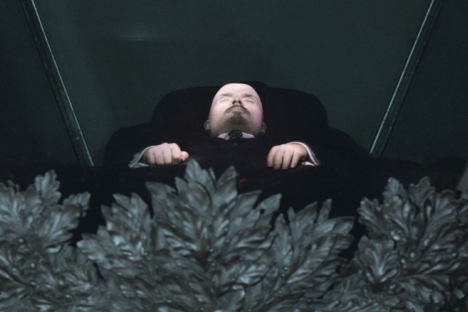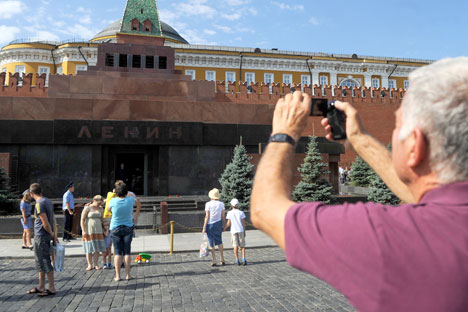
Lenins mausoleum
Lori/Legion-MediaWhat is the strange purple pyramid near the Kremlin wall on the Red Square?
The purple pyramidal structure on Red Square is the Mausoleum, the memorial tomb of Bolshevik leader Vladimir Lenin, who led the October Revolution in 1917, governed Soviet Russia during the Civil War and was a founder of the Soviet Union.
When Lenin died in 1924, the Communist Party leadership decided not to bury its leader, but to embalm his body and place it on public display. The Mausoleum building was designed by the famous architect Alexei Shchusev, who also designed Russia's pavilion in the Giardini park in Venice. The mausoleum was opened to the public in 1930. An interesting detail is that the top tier of the pyramid has a tribune from which Soviet leaders, right up to Mikhail Gorbachev, viewed the parades in Red Square.
Why did the Bolsheviks embalm Lenin?
 Vladimir Lenin, founder of the Soviet Union, lays embalmed in his tomb on Moscow's Red Square. Source: AP
Vladimir Lenin, founder of the Soviet Union, lays embalmed in his tomb on Moscow's Red Square. Source: AP
It is known that embalming was supported by Joseph Stalin. In November 1923, when Lenin was still alive but terminally ill, Stalin suggested that the dead body should be "preserved using embalming" to give the opportunity for everyone to say goodbye.
Part of the Bolshevik leadership met the idea with indignation. Leon Trotsky, who was considered to be the second most important person in the party after Lenin, compared the preservation of the body with the creation of "holy relics," worshiped by Christians: an unheard-of sacrilege for ideological communists. Lenin’s widow, Nadezhda Krupskaya, also reacted very negatively to the preservation of the Bolshevik leader's body.
Why was this needed?
Lenin played an important role in the political system of the USSR. His commandments were followed by all the Soviet leaders so he turned into a sacred figure, kind of like a Communist saint.
"Stylized portraits and busts of Lenin were its icons, his idealized biography its gospel, and Leninism its writings," Harvard University professor Nina Tumarkin wrote in her book "Lenin Lives! The Lenin Cult in Soviet Russia." People dedicated songs and poems to him, his monuments adorned every single city of the Soviet Union.
The Mausoleum also became a symbol of loyalty to the ideals of Leninism. A visit to this place in Moscow was an analogue of a pilgrimage; both for Soviet citizens and for delegations from friendly countries. Close to 2.5 million people visit the tomb each year.
Lenin died more than 90 years ago. How has the body been preserved?
When Lenin's body was dissected and prepared for the exposition, his internal organs were removed and fluids in the body were replaced by a special embalming solution, which slowed down the process of decomposition.
Scientists still keep the body in good condition, injecting preservatives and immersing the body in a bath of preservative solution every year and a half. No more than 23 percent of the body remains. However, it still retains its physical appearance, skin elasticity and flexibility of joints. But the suits in which Lenin lies deteriorate, and have to be changed.
The USSR no longer exists, the Communists are not in power anymore. Why does Lenin still lie in the Mausoleum?
This is the subject of constant debate. Some Russians, especially those critical of the Soviet past, are outraged by the fact that there is a "mummy" in the middle of Red Square and demand that his body be buried. This idea is supported by a number of human rights advocates and members of the clergy.
But there are those who are not ready to bury the famous Bolshevik; primarily, the Communists. They say that Lenin is already buried (the sarcophagus with the body is at a depth of three meters below ground), while the Mausoleum is a unique historic monument, which cannot be deprived of its substance by taking the body out.
The government is neutral. Vladimir Putin, commenting on the possibility of burial, said that this issue should be approached carefully, so as "not to divide society." According to the most recent opinion poll, a majority of Russians (60 percent) generally support the idea of burial.
 More than 60 percent of Russians would like to see Lenin's body properly buried. Source: RIA Novosti
More than 60 percent of Russians would like to see Lenin's body properly buried. Source: RIA Novosti
How much does maintenance of the Mausoleum cost?
According to information on the State Procurement Agency website, 13 million rubles ($199,754) was allocated for "biomedical work to preserve Lenin's lifetime appearance" in the 2016 budget.
How does one visit the Mausoleum? What can you see inside?
 Source: TASS
Source: TASS
To visit the tomb, you have to get up early: the Mausoleum is open from 10:00 to 13:00 on Tuesdays, Wednesdays, Thursdays and Saturdays. Attendance is free, but you can be charged some money to store your goods, like cameras and mobile phones, which are not allowed inside.
The visit is strictly regulated. The sarcophagus with the body is on a plinth. It is forbidden to get close to it or stay for a long time. Under the watchful eye of armed guards, one should walk around the sarcophagus in a semicircle, observing the ever-still revolutionary, and get out to the Kremlin Wall Necropolis, where the cream of Soviet society found their final resting place. From Stalin to Brezhnev to cosmonaut Yuri Gagarin, they are all buried here. Nobody will hurry you up at the necropolis. You may lay flowers on someone's grave – or just wander, thinking about the transience of human life.
All rights reserved by Rossiyskaya Gazeta.
Subscribe
to our newsletter!
Get the week's best stories straight to your inbox